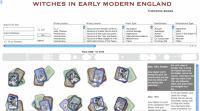Witches in Early Modern England
The Witches in Early Modern England project deploys strategically intersecting digital tools to allow for robust searching and pattern finding within the corpus of texts relating to early modern witchcraft. Beyond that, its open-ended platform encourages further expansion by users, to push the limits of how digital technologies can enhance and inspire the academic interrogation of existing corpora.
To understand early English witchcraft one need to understand textual patterns, to visualize legal trends; how they twist across time and how they manifest material evidence, nearly invisible to the naked eye, suspiciously seen by witch-searchers, and graphically recounted in the texts which expose and hang witches anew with each read-through. Those looking to trace textual representations of witchcraft have, through sources like Early English Books online and Cornell University Library, a large enough corpus at hand that they can beging to see temporal and conceptual patterns emerge from the code. Considerable academic effort have likewise gone into the analysis of witchcraft and witch texts over the last twenty years; these a critical frameworks tell readers as much about cultural and material concerns of early modern England as they do the witches themselves. However graphic and at times gory as these texts may be, the digitization which makes them easy to access and search likewise removes some of their materiality: they become pageless texts. Since these are stories about bodies, the ways in which we visualize them, we suggest might need to have a kind of materiality which is, for better or ill, the basis of the witchcraft text. However, in their fluidity, the digitized texts can be asked to offer up the patterns which emerge throughout the corpus but might escape one set of eyes and hands.The tools and approaches found in digital humanities, which has already provided the digitized text, the key word search, and the date / author search, can provide critics and researchers new ways into stories of witchcraft allowing them to see some of the patterns which span these witch texts and help access the imagined and the insidious in early modern England.
- Login to post comments
Athabasca University does not endorse or take any responsibility for the tools listed in this directory.



